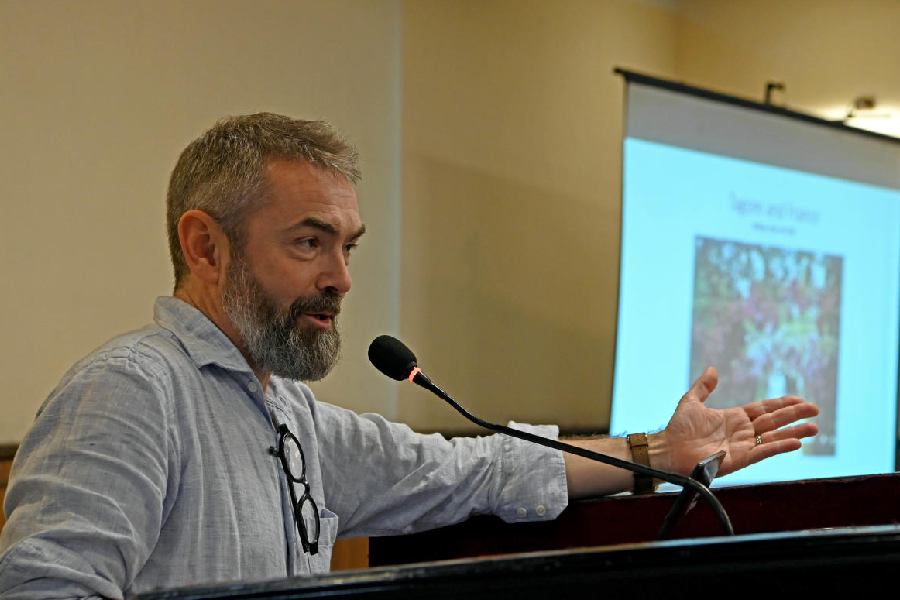Jyotirindranath Tagore had translated Molière’s play Le Bourgeois Gentilhomme and a 16-year-old Rabindranath had played the lead in his elder brother’s production.
Thus was forged a bond which pulled the Bard to the shores of France five times.
Fabien Chartier, who teaches at the University of Rennes, delivered a lecture recently on Tagore and his French connection, organised by Alliance Francaise du Bengale (AFB). Tagore, reminded AFB director Nicolas Facino, who welcomed the audience at The Bengal Club, was hailed in France as “Victor Hugo of India”.
Tagore might not have known French (though Victoria Ocampo, his Francophile Argentine friend, did try to teach him later) but some family members did. While grandfather Dwarkanath Tagore had gone to Paris, his painter-nephews Gaganendranath and Abanindranath were reading a French satirical magazine.
“I discovered copies of L’Assiette au Beurre among documents shared by the Tagore family. You can make out who was reading them if you see Gaganendranath’s caricatures. Jyotirindranath had also translated Maupassant and Hugo,” said Chartier, whose doctoral thesis is on Tagore’s reception in Britain and France.
Chartier introduced listeners to Alexandra David-Neel, the first female explorer to have spent years in Tibet, Ladakh and Sikkim, and shared an anecdote about Tagore seeking letters of introduction from her when she visited Calcutta in March 1912.
“Tagore’s plan was to leave for Marseilles and Lyon on March 19, before going to London,” he said, showing a copy of David-Neel’s letter introducing Tagore to French intellectuals, dated March 17. “Tagore knew Paris was the place to be culturally but he fell sick and had to go straight to London in June. In the meantime, he kept translating Gitanjali into Song Offerings.”
Two poems from the collection were published in The Times, which fascinated Saint-John Perse, a French poet in London, who advised Tagore to get Gitanjali translated into French, recommending poet Paul Claudel and Andre Gide for the job.
But Gide’s L’Offrande Lyrique (Song Offerings) would not be the first French translation of Tagore. Two lesser-known translators, Jean de Rosen and Henry Davray, were before him. “This is why Gide struggled to get exclusive translation rights.”
Tagore’s play Post Office, translated by Gide as Amal et la Letrre du Roi, is still performed in France, especially in children’s wings of hospitals, for the positive message it delivers, Chartier said.
During his trips, Tagore would accept the invitation of banker and patron of the arts Albert Kahn, who had set up La Maison Autour du Monde. “Tagore spent most of his time at Kahn’s place near Paris. Kahn also had a villa in Cap Martin, in the south of France. Tagore rested there for some days in 1924 on his way to Peru. He really liked France.”
Tagore had been to the country earlier, though for short durations. In 1878, he spent two days and in 1890, sent a letter to Mrinalini Devi from the Eiffel Tower.
In 1920-21, during his stay at Kahn’s, Tagore met Orientalist Sylvain Levi and invited him to Visva-Bharati, which he was setting up. Levi would spend a year at Santiniketan, as a specialist in Tibetan and Pali, other than Chinese and French. Andrée Karpeles, a painter, also spent a lot of time in Santiniketan.
Chartier touched upon Tagore’s exchanges with another French icon, Romain Rolland. “Tagore travelled to Japan in 1916 and delivered his famous Message of India to Japan. Rolland read the text and contacted Tagore.”
According to Chartier, the people Tagore met in Europe belonged to two categories — one with whom he could sympathise; and another with a feeling of superiority. Henri Bergson, the French philosopher Tagore met twice belonged to the second.
Chartier “fell off the chair” at finding, amid letters from unknown senders at Rabindra Bhavana, one signed “Marguerite”. “It was from Marguerite Yourcenar, who revolutionised 20th-century French literature. In her memoir, she has mentioned being influenced by Tagore when she was young. She sent him her first novel.”
He also shared an anecdote of a French taxi driver recognising Tagore, recounted by his son Rathindranath.
“Tagore,” Chartier summed up, “was influential at different levels in France and the influence was not the same at each”.











